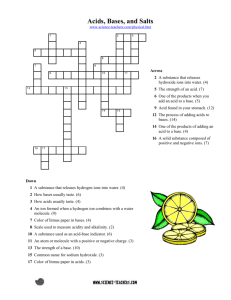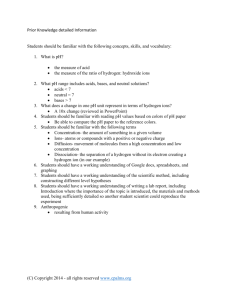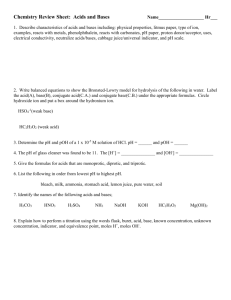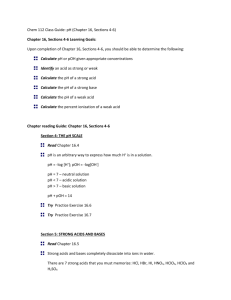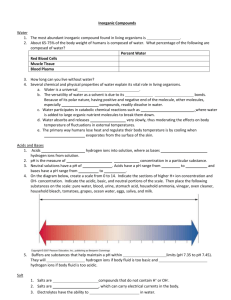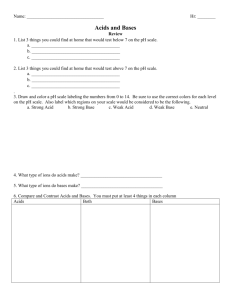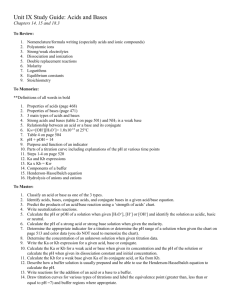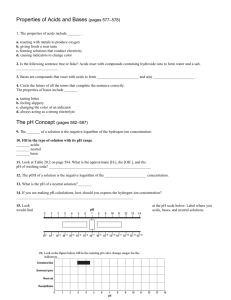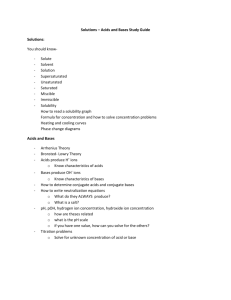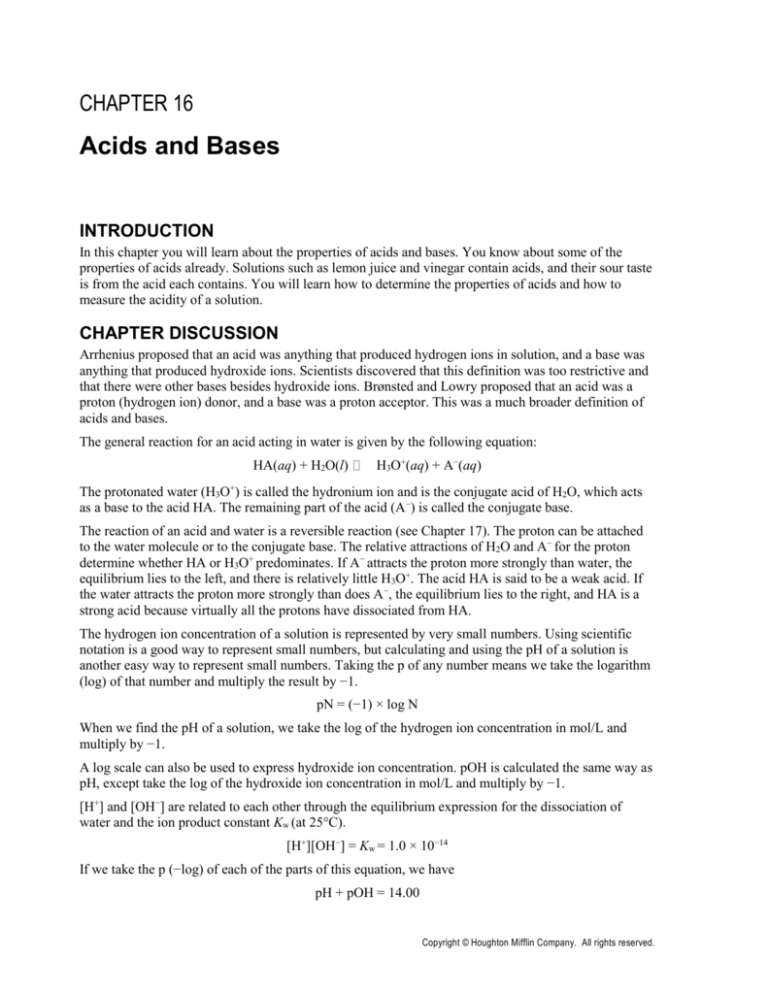
CHAPTER 16
Acids and Bases
INTRODUCTION
In this chapter you will learn about the properties of acids and bases. You know about some of the
properties of acids already. Solutions such as lemon juice and vinegar contain acids, and their sour taste
is from the acid each contains. You will learn how to determine the properties of acids and how to
measure the acidity of a solution.
CHAPTER DISCUSSION
Arrhenius proposed that an acid was anything that produced hydrogen ions in solution, and a base was
anything that produced hydroxide ions. Scientists discovered that this definition was too restrictive and
that there were other bases besides hydroxide ions. Brønsted and Lowry proposed that an acid was a
proton (hydrogen ion) donor, and a base was a proton acceptor. This was a much broader definition of
acids and bases.
The general reaction for an acid acting in water is given by the following equation:
HA(aq) + H2O(l)
H3O+(aq) + A−(aq)
The protonated water (H3O+) is called the hydronium ion and is the conjugate acid of H2O, which acts
as a base to the acid HA. The remaining part of the acid (A−) is called the conjugate base.
The reaction of an acid and water is a reversible reaction (see Chapter 17). The proton can be attached
to the water molecule or to the conjugate base. The relative attractions of H2O and A− for the proton
determine whether HA or H3O+ predominates. If A− attracts the proton more strongly than water, the
equilibrium lies to the left, and there is relatively little H3O+. The acid HA is said to be a weak acid. If
the water attracts the proton more strongly than does A−, the equilibrium lies to the right, and HA is a
strong acid because virtually all the protons have dissociated from HA.
The hydrogen ion concentration of a solution is represented by very small numbers. Using scientific
notation is a good way to represent small numbers, but calculating and using the pH of a solution is
another easy way to represent small numbers. Taking the p of any number means we take the logarithm
(log) of that number and multiply the result by −1.
pN = (−1) × log N
When we find the pH of a solution, we take the log of the hydrogen ion concentration in mol/L and
multiply by −1.
A log scale can also be used to express hydroxide ion concentration. pOH is calculated the same way as
pH, except take the log of the hydroxide ion concentration in mol/L and multiply by −1.
[H+] and [OH−] are related to each other through the equilibrium expression for the dissociation of
water and the ion product constant Kw (at 25°C).
[H+][OH−] = Kw = 1.0 × 10−14
If we take the p (−log) of each of the parts of this equation, we have
pH + pOH = 14.00
Copyright © Houghton Mifflin Company. All rights reserved.
Chapter 16: Acids and Bases
149
This means that, for any aqueous solution at 25°C, the sum of pH and pOH will always equal 14. If we
know the pH, we can easily find the pOH and vice versa.
A buffered solution resists large changes in pH even when strong acid or strong base is added. The
addition of even small amounts of strong acid or base can greatly lower or raise the pH of a nonbuffered
solution. Living systems contain many different kinds of buffers to help keep fluids and tissues at the
correct pH, even under stressful conditions.
LEARNING REVIEW
1.
Explain the differences between the Arrhenius concept of an acid and a base, and the concept of
Brønsted and Lowry.
2.
For the reaction of perbromic acid with water:
HBrO4(aq) + H2O(l) H3O+(aq) + BrO4−(aq)
3.
a.
Which two substances are an acid–conjugate base pair?
b.
Which two substances are a base–conjugate acid pair?
Write equations to show what happens when each of the acids below reacts with water.
a.
H2S
b.
HNO2
4.
Show how acetic acid, HC2H3O2, reacts with water by drawing Lewis structures for water and its
conjugate acid.
5.
When formic acid, HCOOH, is mixed with water, the resulting solution weakly conducts an
electric current.
6.
a.
Is formic acid a strong or a weak acid?
b.
Toward which side of the reaction does the equilibrium lie?
c.
Which species is the stronger base, H2O or HCOO−?
Which of the acids below are strong acids and which are weak acids?
a.
HF
b.
H2SO4
c.
HC2H3O2
d.
HClO4
7.
The expression for the dissociation of water is Kw = [H+][OH−]. Why does liquid water not appear
in this expression?
8.
All the aqueous solutions below are at a temperature of 25°C.
9.
a.
What is the [H+] of a solution for which [OH−] = 1.5 × 10−6 M?
b.
What is the [H+] of a solution for which [OH−] = 6.3 × 10−3 M?
c.
What is the [OH−] of a solution for which [H+] = 3.25 × 10−1 M?
What is the [H+] of a 0.1 M solution of NaOH in water at 25°C?
10. What is the pH of each of the solutions below?
a.
A solution in which [H+] = 3.0 × 10−3 M
Copyright © Houghton Mifflin Company. All rights reserved.
150
Chapter 16: Acids and Bases
b.
A solution in which [H+] = 5.2 × 10−6 M
c.
A solution in which [OH−] = 1.4 × 10−1 M
11. What is the pOH of each solution below?
a.
[OH−] = 4.89 × 10−10 M
b.
[OH−] = 3.2 × 10−5 M
c.
[H+] = 1.6 × 10−8 M
12. For any solution, what is the relationship between pH and pOH?
13. The pH of lemon juice is 2.1. What is the pOH?
14. The pOH of black coffee is 9.0. What is the pH?
15. Calculate the [H+] or [OH−] for the solutions below.
a.
Milk has a pH of 6.9. What is the [H+]?
b.
Oven cleaner has a pH of 13.4. What is the [OH−]?
c.
A phosphate-containing detergent has a pOH of 4.7. What is the [OH−]?
16. What is the pH of each of the following solutions?
a.
0.02 M HCl
b.
3.5 × 10−3 M HNO3
17. HCl is added to a solution containing H2CO3 and NaHCO3.
a.
Use an equation to show what would happen to the hydrogen ions from the HCl.
b.
Why would the pH of this solution not change drastically when the HCl is added?
ANSWERS TO LEARNING REVIEW
1.
Arrhenius’s model of acids and bases proposes that acids produce hydrogen ions in aqueous
solution while bases produce hydroxide ions. The Brønsted-Lowry model of acids and bases
proposes that acids are proton donors while bases are proton acceptors.
2.
3.
a.
For the reaction of perbromic acid with water, perbromic acid/perbromate (HBrO4/BrO4−) is
the acid–conjugate base pair.
b.
Water/hydronium ion (H2O/H3O+) is the base–conjugate acid pair.
One model of an acid postulates that acids donate protons in aqueous solutions. The proton
acceptor is the base, water. In aqueous solutions, acids donate protons to the base water to form
the hydronium ion and the conjugate base.
a.
H2S(aq) + H2O(l) HS−(aq) + H3O+(aq)
b.
HNO2(aq) + H2O(l) NO2−(aq) + H3O+(aq)
4.
Copyright © Houghton Mifflin Company. All rights reserved.
Chapter 16: Acids and Bases
151
5.
a.
When formic acid is mixed with water, a weak electric current is generated. An electrical
current requires ions. We know that only a few ions are in this solution because the current
is weak. So formic acid is a weak acid.
b.
Because there are only a few formate and hydronium ions formed, the equilibrium lies
toward the left, that is, toward undissociated formic acid.
c.
A base can be defined as a proton acceptor. The formate ion has a stronger attraction for
hydrogen ions than water does because most of the formic acid is undissociated. The formate
ion has pulled the hydrogen ion away from the hydronium ion so HCOO− is a stronger base
than water is.
6.
The common strong acids are HCl, HNO3, H2SO4 and HClO4. So, b, H2SO4, and d, HClO4, are
strong acids. HF and HC2H3O2 are weak acids.
7.
The concentration of liquid water does not appear in the expression for the dissociation of water
because the concentration of water changes very little when dissociation occurs. The
concentration of water is considered a constant.
8.
a.
The product of [H+][OH−] is always equal to 1.0 × 10−14.
Kw = 1.0 × 10−14 = [H+][OH−]
When we are given either [H+] or [OH−], we can calculate the other if we remember that Kw
is equal to 1.0 × 10−14. In this problem, we know that [OH−] = 1.5 × 10−6 M, and we want to
know [H+]. Rearrange the equation to isolate [H+] on one side by dividing both sides by
[OH−].
Kw = [H+][OH−]
Divide both sides by [OH−].
Kw
[H+ ][OH ]
=
[OH ]
[OH ]
[H + ] =
Kw
[OH ]
Substitute values into the equation.
[H + ] =
1.0 1014
1.5 106
[H+] = 6.7 × 10−9 M
Copyright © Houghton Mifflin Company. All rights reserved.
152
Chapter 16: Acids and Bases
b.
We are given [OH−] and asked for [H+]. We can use the Kw expression to find [H+].
Rearrange the equation to isolate [H+] on one side.
Kw = [H+][OH−]
Kw
[H+ ][OH ]
=
[OH ]
[OH ]
[H + ] =
Kw
[OH ]
Substitute values into the equation.
[H + ] =
1.0 1014
6.3 103
[H+] = 1.6 × 10−12 M
c.
We are given [H+] and asked for [OH−]. Use the Kw expression to find [OH−]. Rearrange the
Kw expression to isolate [OH−] on one side by dividing both sides by [H+].
Kw = [H+][OH−]
Kw
[H+ ][OH ]
=
[H ]
[H ]
[OH ] =
Kw
[H ]
Now substitute values into the equation.
[OH ] =
1.0 1014
3.25 101
[OH−] = 3.08 × 10−14 M
9.
When NaOH dissolves in water, each mole of NaOH forms a mole of Na+ ions and a mole of OH−
ions. A solution that is 0.1 M NaOH is also 0.1 M OH−. We can use the Kw expression to find [H+].
Kw = [H+][OH−]
Rearrange the equation to isolate [H+] on one side.
Kw
[H+ ][OH ]
=
[OH ]
[OH ]
[H + ] =
Kw
[OH ]
Substitute values into the equation, and find [H+].
[H + ] =
1.0 1014
0.1
[H+] = 1 × 10−13 M
The amount of H+ is very small compared with the amount of OH−.
Copyright © Houghton Mifflin Company. All rights reserved.
Chapter 16: Acids and Bases
153
10. The pH scale is a way to write very small numbers in a more convenient form. pH = −log[H+].
a.
2.52
b.
5.28
c.
We are given [OH−] and are asked for pH. We must find [H+] before we can find the pH.
Use the Kw expression to find [H+].
Kw = [H+][OH−]
[H + ] =
[H + ] =
Kw
[OH ]
1.0 1014
= 7.14 × 10−14
1.4 101
Now that we know [H+], we can find the pH. The pH of a solution that contains
1.4 × 10−1 M OH− is 13.15.
11.
a.
The pOH of a solution is equal to −log [OH−]. The pOH of a solution that contains
4.89 × 10−10 M OH− is 9.311.
b.
The pOH of a solution is equal to −log [OH−]. The result is 4.49. The pOH of a solution that
contains 3.2 × 10−5 M OH− is 4.49.
c.
To find the pOH of this solution, we must find the OH− concentration. Use the Kw expression
to find [OH−].
Kw = [H+][OH−]
[OH ] =
[OH ] =
Kw
[H ]
1.0 1014
= 6.3 × 10−7 M
1.6 108
The concentration of OH− is 6.3 × 10−7 M. The pOH of a solution that contains
1.6 × 10−8 M H+ is 6.20.
12. For all solutions the sum of pH and pOH must equal 14.00. This relationship is derived from the
Kw expression, [H+][OH−] = 1.0 × 10−14. If we know either the pH or the pOH, we can find the
other using this relationship. For example, if the pH of a solution is 4.5, then the pOH is 14.00
minus 4.5, which equals 9.5.
13. If we know either the pH of a solution or the pOH, we can calculate the other. pH and pOH are
related by the expression
pH + pOH = 14.00
This equation is derived from
[H+][OH−] = Kw = 1.0 × 10−14
If the pH of lemon juice is 2.1, then the pOH is
pOH = 14.00 − pH
pOH = 11.9
Copyright © Houghton Mifflin Company. All rights reserved.
154
Chapter 16: Acids and Bases
14. pOH and pH are related to each other by the equation
pH + pOH = 14
If the pOH of black coffee is 9.0, then the pH is
pH = 14.00 − pOH
pH = 5.0
15.
a.
We want to find [H+] of milk, and the pH of milk is 6.9. To find the pH of milk from [H+],
we take minus the log of [H+], so to find [H+] from pH we must go backward and undo the
log[H+]. We can do this by finding the inverse log of −pH.
[H+] = inverse log(−pH)
[H+] = inverse log(−6.9) = 1 × 10−7 M
b.
We want to find the [OH−] of oven cleaner, which has a pH of 13.4. pH and pOH are related
to each other by the expression pH + pOH = 14.00.
pOH = 14.00 − pH
pOH = 14.00 − 13.4
pOH = 0.6
[OH−] = inverse log(−0.6) = 3 × 10−1 M
c.
We want to know the [OH−] of a phosphate-containing detergent with a pOH of 4.7. We
must go backward from pOH to [OH−].
[OH−] = inverse log(−4.7) = 2 × 10−5 M
16.
a.
HC1 is a strong acid. This means that, when HC1 is dissolved in water, only H+ ions and Cl−
ions are present. If a solution is described as 0.02 M HCl, then it actually contains 0.02 M H+
and 0.02 M Cl−. Because the pH depends on the hydrogen ion concentration, we can
calculate the pH of a solution of HCl if we know the molar concentration of HCl.
0.02 mol/L HCl = 0.02 mol/L H+ and 0.02 mol/L Cl−
pH = −log[H+]
pH = −log(0.02)
pH = 1.7
b.
3.5 × 10−3 mol/L HNO3 dissolved in water produces 3.5 × 10−3 mol/L H+ and 3.5 × 10−3
mol/L NO3−. Use the hydrogen ion concentration to calculate the pH.
pH = −log[H+]
pH = −log(3.5 × 10−3)
pH = 2.46
Copyright © Houghton Mifflin Company. All rights reserved.
Chapter 16: Acids and Bases
155
17.
a.
Hydrogen ions produced when HCl is dissolved in water would react with the bicarbonate
ion, HCO3−, which has a high affinity for hydrogen ions.
HCO3− + H+ H2CO3
b.
The pH of a solution is determined by the number of hydrogen ions in a solution. In a
solution that contains a mixture of NaHCO3 and H2CO3, the [H+] remains steady. H2CO3 is a
weak acid, so most of the acid is in the undissociated form, and not much hydrogen ion is
produced. But most of the NaHCO3 is dissociated as Na+ and HCO3−. When an outside
source of hydrogen ion is added to a buffered solution, the hydrogen ions are removed from
the solution by reacting with the conjugate base, HCO3−, which has a high affinity for
hydrogen ions. The hydrogen ions are removed from the solution, and the pH of the solution
does not change much.
Copyright © Houghton Mifflin Company. All rights reserved.

